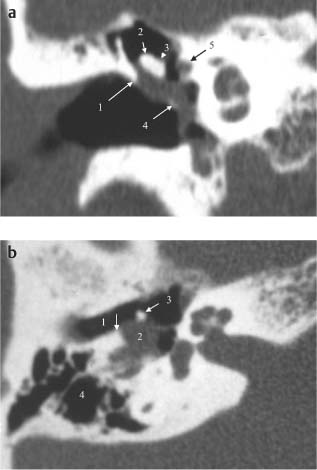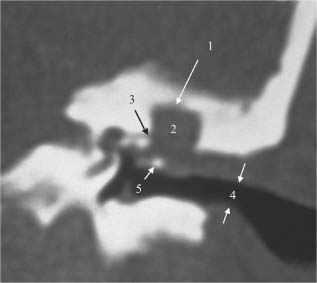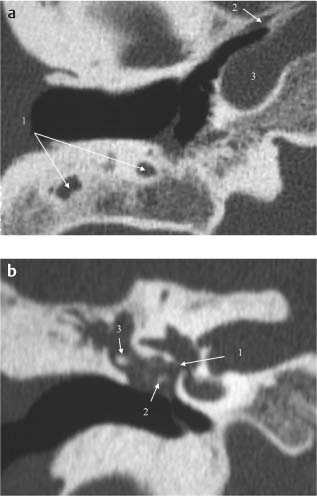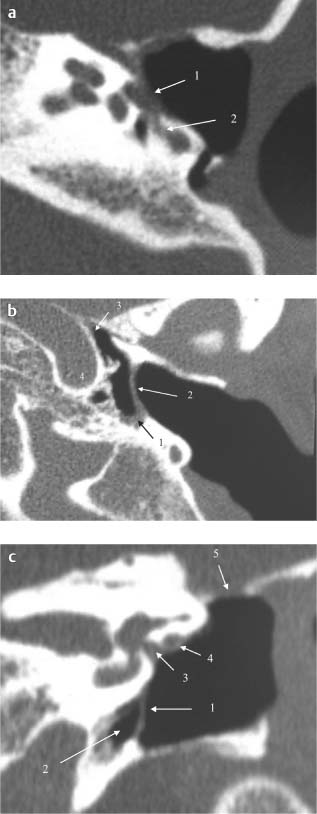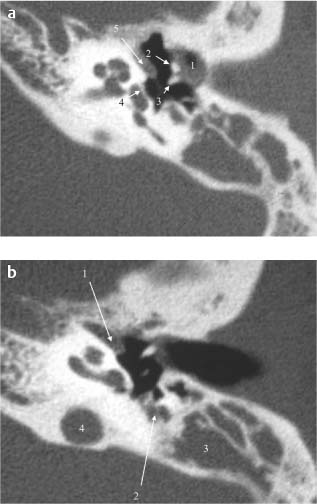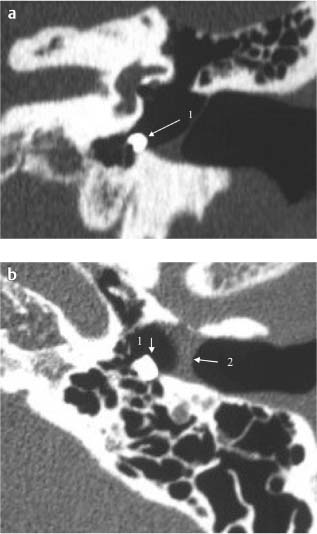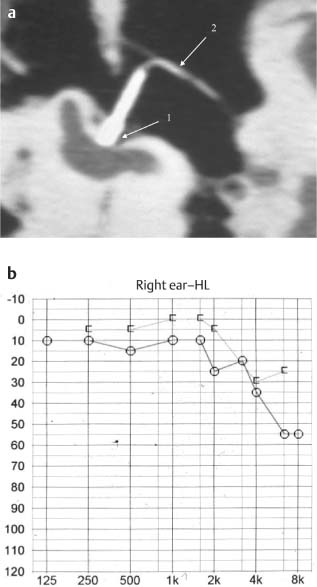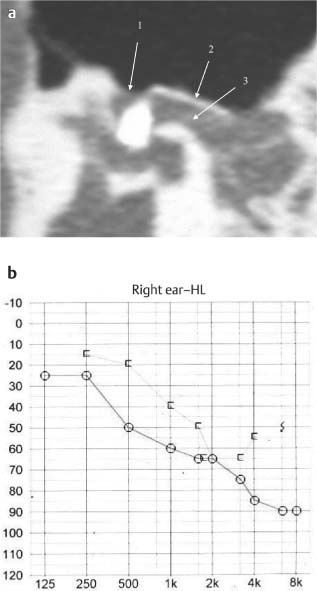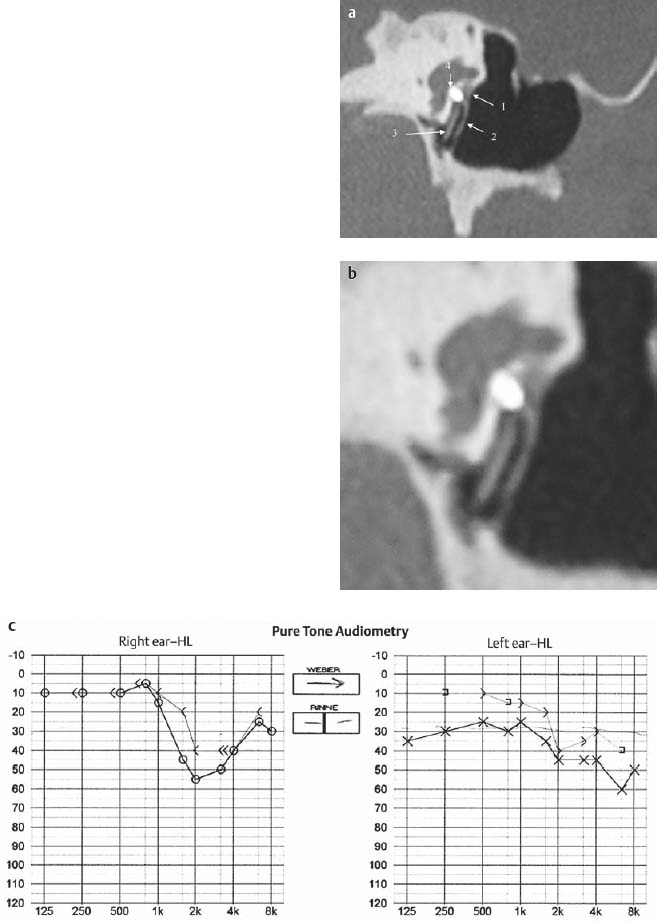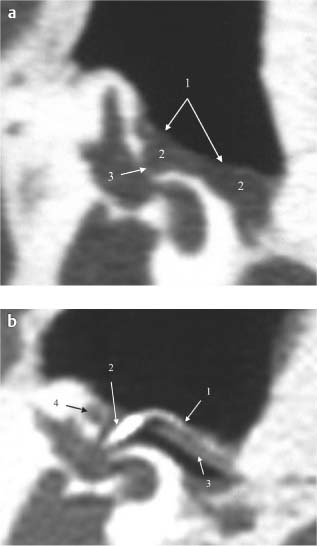Chapter 10 Imaging for Tympanoplasty and Mastoidectomy A good pneumatization suggests good ventilation of the middle ear cleft in childhood and is a prerequisite for planning a closed-cavity technique (see Fig. 145a). A sclerotic temporal bone is the result of chronic ventilation problems in childhood and raises doubts over the long-term success of a closed-cavity reconstruction (see Fig. 145c, d). The presence of extensive scars and thickened mucosa in the mastoid cells or the presence of only a few large pneumatic cells surrounded by sclerotic bone—a typical feature of a cholesterol granuloma—is an indication for a mastoidectomy should surgery be required (see Fig. 145b). A sclerotic mastoid with no evidence of air in the protympanum and along the proximal eustachian tube close to the horizontal segment of the internal carotid artery (ICA) may be the expression of severe eustachian tube dysfunction and should raise doubts over the likelihood of successful long-term aeration of the mastoid after a closed cavity myringo- and/or ossiculoplasty (Fig. 150a–d). Fig. 150 The patient is a 65-year-old female with a history of repeated bilateral acute otitis media in childhood and bilateral chronic otitis media with central perforation. A bilateral tympanoplasty with right interposition of autologous incus was performed. The image was taken 10 years postoperative. a Left axial scan. Key level 4: geniculate ganglion. The image shows severely reduced pneumatization of the mastoid. The proximal tympanic segment of the facial nerve is covered by bone (1). There is a dehiscent geniculum with accompanying thickened mucosa (2) and no aeration of the tympanic ostium of the eustachian tube (3). b Left coronal scan. Key level 4: geniculum of the facial nerve. Here we can see a dehiscent geniculum (1) with accompanying thickened mucosa (scar?) (2). d Right coronal scan. Key level 4: geniculum of facial nerve. The image shows the geniculum covered by bone (1). There is a retracted tympanic membrane with malleus handle (2) and interposed autologous incus and a scar in the hypotympanum (3). Bone atrophy at the scutum occurs in tympanosclerosis and in chronic otitis media with marginal perforation and cholesteatoma (Fig. 151a, b). The bone defect created by a cholesteatoma has sharp margins (as if cut out by a knife; see Chapter 5, Mastoidectomy and Epitampanectomy, pp. 152–159, and Figs. 151, 152). On computed tomography (HRCT) scans, the presence of a cholesteatoma cannot be directly diagnosed but only indirectly suspected when the typical bone destruction is present. In addition to bone destruction, high-resolution computed tomography (HRCT) helps in identifying the extent of possible keratin retention behind a marginal perforation (Fig. 151a, b) or in a deep retraction pocket and, therefore, contributes to determination of the extent of the disease. However, it should be stressed that the radiologist cannot directly diagnose a cholesteatoma but only suspect its presence when he or she sees its most reliable “indirect” sign which is the typical bone destruction (as if cut out by a knife) on the CT scan. Therefore, one cannot ask the radiologist whether a cholesteatoma is present but only whether the indirect signs suggest its presence. Fig. 151 Right chronic otitis media with marginal perforation and suspected cholesteatoma in a 38-year-old male. No history of repeated ear infections in childhood. There was bad smelling right ear secretion with slight earache over the previous 6 months. a Coronal scan, right side. Key level: anterior tympanic segment of the fallopian canal. The scutum appears amputated as if a sharp knife was used (1). There is accumulation of material (keratin?) between the amputated scutum, malleus (2), and incus (3), and a slightly retracted tympanic membrane (TM) with malleus handle (4). Also seen is a dehiscent tympanic segment of the facial nerve (5). b Axial scan, right side. Key level 1: oval window. The image shows an amputated scutum (1), retention of material (keratin?) in the facial recess (2), the malleus (3), and good pneumatization of the antrum and mastoid (4). Conclusion: In view of the good pneumatization, a closed tympanomastoidectomy with removal of the cholesteatoma, removal of the malleus head and eroded incus, and interposition of a modified 4-mm titanium incus was carried out. Fig. 152 The patient is a 42-year-old male with a long history of recurrent ear infections in the left ear in childhood and progressive left hearing loss and tinnitus with continuous ear secretion from the left ear. Left coronal scan. Key level 1: oval window. The image shows a sharp-edged defect of bone in the area of the scutum and roof of the epitympanum (1). There is a high degree of suspicion for cholesteatoma. Also seen is accumulation of debris (keratin?) in the attic (2), fistula of the lateral semicircular canal (3), a narrow cartilaginous EAC (4), and the malleus (5). There is no pneumatization of the temporal bone. Conclusion: In view of the reduced pneumatization, the patient underwent an open mastoido-epitympanectomy with myringoplasty and partial obliteration of the cavity with the occipital myosubcutaneous flap. The ossiculoplasty (total reconstruction of the ossicular chain with FTT) was performed a year later since the cholesteatoma had destroyed the stapes arch, incus, and the proximal part of the malleus handle. The chances of successful long-term grafting of the tympanic membrane are greatest if the temporal bone is well pneumatized. Chronic serous otitis media may lead to adhesive retractions of the tympanic membrane and ultimately to a completely atelectatic middle ear; should perforation then occur with a negative Valsalva maneuver, surgical closure of the perforation may deprive the middle ear of adequate ventilation. HRCT is very helpful for evaluating the likely success of surgery in this situation; in our experience the chances of success exist when there is visible air accumulation along the proximal eustachian tube and in the protympanum (Fig. 153a, b). Even the intraoperative removal of scars occluding the tympanic ostium of the eustachian tube and the use of thick Silastic sheeting with prolongation toward the ostium of the eustachian tube will not improve middle ear ventilation in the absence of visible residual air in the proximal eustachian tube and/or protympanum on the preoperative HRCT scans of ears with a perforated or atelectatic tympanic membrane. Usually these ears present with a severe retraction and atrophy of the tympanic membrane and with a sclerotic temporal bone (see Fig. 150a–d). Ears with severe atelectatic tympanic membranes and signs of insufficient patency of the tympanic ostium of the eustachian tube may present with radiologic signs of chronic osteitis involving the postero-lateral bony wall of the sinus tympani. This is particularly the case when there is an associated small perforation of the drum with intermittent secretion (Fig. 154a–c). During surgery the osteitic bone has to be removed with a diamond drill to eliminate the chronic source of the infection. Fig. 153 The patient is a 64-year-old female with repeated bilateral ear infections in childhood and bilateral severe conductive hearing loss. A left radical mastoidectomy was carried out elsewhere 12 years earlier. a Right axial scan. Key level 3: protympanum. There is a sclerotic mastoid with enlarged residual pneumatic cells (cholesterol granuloma?) (1) and no scars at the tympanic ostium of the eustachian tube (2). The ICA is also visible (3). b Right coronal scan. Key level 1: oval widow. The image shows a thin footplate (1) and a barely visible lenticular process of the incus and stapes head (2). The malleus head is away from the anterior tympanic spine (3). Conclusion: The patient underwent an endaural ossiculoplasty with FTT (no foot, shaft on footplate stabilized by stapes arch and small wedges of tragal cartilage). The decision for surgery was based on the excellent radiologic condition of the protympanum and tympanic ostium of the eustachian tube. Fig. 154 The patient is a 64-year-old female with a long history of recurrent ear infections as a child, who underwent a bilateral open tympanomastoidectomy 10 years previously. The patient suffered from recurrent allergic rhinitis and total conductive hearing loss on both sides. a Axial scan of left ear. Key level 1: oval window. Severe retraction of the thin tympanic membrane (1) can be seen as well as a thickened footplate without a visible stapes arch. There is chronic infection with signs of osteitis (atrophic bone) in the superior sinus tympani (2). b Axial scan of left ear. Key level 3: protympanum. The image shows thickened mucosa in the sinus tympani (1), a thickened tympanic membrane (2), and a clear tympanic ostium of the eustachian tube (3). The ICA (carotid bend) is completely covered by bone (4). c Coronal scan of left ear. Key level 1: oval window.There is a severely retracted tympanic membrane (1), a ventilated hypotympanum (2), a narrow oval window niche filled with scar tissue (3), and a dehiscent facial nerve above the oval widow niche (4). The dura of the MCF is exposed at the upper wall of the attic (5). No pneumatic cells are visible. Conclusion: In view of the good radiologic appearance of the protympanum and tympanic ostium of the eustachian tube, the patient underwent an ossiculoplasty (FTT with cartilage disk on footplate, thick Silastic sheeting in the meso-, hypo-, and protympanum) and myringoplasty (tragal perichondrium). The success of ossiculoplasty has to be considered in the context of the general condition of the middle ear cleft. Generally, the extent of an ossicular defect is proportional to the degree of the original pathology. Since the reduction of pneumatization is the expression of repeated ear infections in childhood, one can say that the chances of long-term success of ossiculoplasty are, in general, inversely proportional to the degree of sclerosis of the temporal bone. Ossicular defects of the malleus and incus can be evaluated well on HRCT (Fig. 155a–d). Defects of the stapes are less apparent and require the use of multiplanar reconstruction at a workstation for their definition (see Figs. 158–161). Scars and adhesions in the attic (Fig. 155c) reduce the mobility of the malleus head and incus body and are an indication for an ossicular by-pass of the epitympanum (see Basic Situations in Ossiculoplasty, p. 48). Fig. 155 The patient is a 38-year-old male with a history of recurrent left ear infections and chronic otitis media with marginal superior perforation and conductive hearing loss. The image shows the status after two previous closed tympanomastoidectomies—carried out else-where—with removal of a cholesteatoma and interposition of an autologous incus between the malleus handle and stapes head without improvement of conductive hearing. Recurrent left marginal anterosuperior perforation of the tympanic membrane can be seen, with clear accumulation of keratin within the middle ear. a Axial scan of left ear. Key level 1: oval window. There is accumulation of keratin (1) lateral to the malleus (2) and incus (3), and no stapes arch is visible. A thickened footplate (4), a large dehiscence of the semicanal of the tensor tympani muscle (5), and reduced pneumatization of the mastoid with a few enlarged cells filled with scar tissue (cholesterol granuloma?) can also be seen. b Left axial scan. Key level 2: round window. The tympanic ostium of the eustachian tube appears to be filled with thickened polypoid mucosa (1). The sinus tympani (2) and mastoid cells (3) are filled with scars and there is a high jugular bulb (4). d Left coronal scan. Key level 4: mastoid segment of the fallopian canal. The mastoid pneumatization is reduced. There are signs of chronic infection along the posterior wall (1) of the fallopian canal (2). The ICA (3) can also be seen. Conclusion: In view of the poor pneumatization the decision was made for an open mastoido-epitympanectomy with staged ossiculoplasty (absence of stapes arch), myringoplasty (temporal fascia), and partial obliteration of the mastoid cavity with the occipital myosubcutaneous flap (see p. 152). An FTTP was introduced into the left ear 1 year later obtaining a closure of the air–bone gap to within 20 dB. The advent of ossicular prostheses made of radio-opaque materials, particularly titanium, has opened up a new field for the postoperative radiologic evaluation of ossicular reconstructions. Computer-aided reading of the scans at a workstation (multiplanar reconstructions) provides very accurate information on the size and position of the prosthesis. The surfaces of the titanium incus (TI) that are in contact with the stapes head and malleus handle have to be roughened for better postoperative stability (see p. 53). HRCT scans can help in confirming that the interposed TI has remained in the correct position (Fig. 156a, b). Fig. 156 The patient is a 34-year-old female. Interposition of a 3.5-mm TI following right longitudinal fracture of the temporal bone with incus luxation. a Coronal scans. Key level 1: anterior oval widow niche. Six months postoperative. The 3.5-mm TI is in a perfect position between the malleus handle and the head of the stapes. The notch for the contact with the malleus handle (1) is visible. The inclination of the interposed prosthesis is less then 45°. b Axial scan. Key level 2: upper round window niche. The contact between the malleus handle (1) and the notch of the prosthesis is perfect. Conclusion: The stability of the interposed incus was obtained by roughening the contact surfaces of the prosthesis with the diamond drill. The inclination of the TI applied between the malleus handle and stapes head should not be less than 30° (ideally 45° or more) for stability and good transmission of sound vibrations. Failure to observe this limitation may lead to a displacement of the interposed TI with recurrence of the conductive hearing loss. The dislocated prosthesis can be easily identified on conventional HRCT scans (Fig. 157a, b). Fig. 157 The patient is a 70-year-old male. Interposition of a modified 4-mm TI following revision of a closed tympanomastoidectomy (chronic otitis media with marginal perforation and cholesteatoma) in the left ear. The tensor tympani tendon was cut by the first surgeon. The malleus handle has a very anterior position. The inclination of the interposed incus was less than 30°. a Coronal scan. Key level 1: oval widow niche. Six months postoperative. The TI lies free in the hypotympanum (1) and is no longer in the correct position between the malleus handle and the head of the stapes. b Axial scan. Key level 3: protympanum. The TI (1) has fallen into the hypotympanum because of the insufficient fixation (less than 30° inclination, cut tensor tympani tendon). The tympanic membrane is thickened by the myringoplasty (2). Conclusion: Cutting of the tensor tympani tendon destabilizes an incus interposition. Total reconstruction of the ossicular chain gives different functional results depending upon the ossicular status and the quality of ventilation of the middle ear cleft. HRCT is very valuable for evaluating the preoperative condition of the ossicular chain and selecting sufficiently ventilated ears. The Fisch titanium total (FTT) described in this book (see p. 80) is extremely versatile and can be adapted to any type of anatomic situation. Today, computer-guided analysis of the postoperative HRCT enables us to accurately identify and analyze the reasons for success and failure of the ossiculoplasties. Postoperative multiplanar reconstructions have demonstrated that: Fig. 158 The patient is a 27-year-old female 5 years after closed tympanomastoidectomy and second-stage ossiculoplasty in the right ear. a Multiplanar reconstruction. The FTT is in a perfect position with its foot (1) fixed by the spike on the center of the footplate. The prosthesis head (2) is in good contact with the tympanic membrane. b Audiometry showing the 10-dB air–bone gap in the speech frequencies of the right ear. Conclusion: The FTT has been kept in position for 5 years by the spike of the prosthesis foot. Fig. 159 The patient is a 69-year-old male 5 years after open mastoido-epitympanectomy with staged ossiculoplasty in the right ear. a Multiplanar reconstruction. Five years postoperative. The tympanic membrane (1) is retracted. The prosthesis head (2) is in perfect contact with the tympanic membrane. The prosthesis foot with spike is positioned over the central footplate but displaced toward the vestibule. The thick (1-mm) Silastic sheeting (3) has prevented excessive medialization of the prosthesis. The middle ear spaces are filled with adhesions. b Pure tone audiometry (PTA). The inner ear hearing loss is pre-existent. The air–bone gap of the operated right ear is 17 dB for the speech frequencies. The patient has a symmetric sensorineural hearing loss and a complete conductive hearing loss on the opposite left side. He is still very satisfied with the result of the ossiculoplasty and does not wish to wear a hearing aid. Conclusion: The foot with spike has stabilized the FTT in spite of intermittent problems of middle ear ventilation. The thick Silastic sheeting has prevented excessive medialization of the prosthesis. The hearing gain has remained remarkably stable. Fig. 160 The patient is a 36-year-old male. Seven years after revision mastoido-epitympanectomy with subsequent ossiculoplasty (FTT) in the left ear. a Multiplanar reconstruction. The tympanic membrane (1) extends from the lateral semicircular canal to the inferior tympanic sulcus. The head of the 3.5-mm-long FTT (2) has good contact with the tympanic membrane. There are no signs of extrusion in spite of absent cartilage protection. The thick (1-mm) Silastic sheeting (3) has remained through the years in the desired, original position. The foot of the prosthesis (4) is well centered on the footplate. b Multiplanar reconstruction (closer view). c Audiometry showing the 10-dB air–bone gap achieved in the left ear 7 years after introduction of the FTT. Conclusion: The excellent biocompatibility and flexibility of the FTT are well documented by multiplanar reconstruction HRCT. The Silastic sheeting has maintained its position through the years because of its shape (prolongation for the protympanum). Fig. 161 The patient is a 65-year-old female with recurrent middle ear infections during childhood. A left radical mastoidectomy was performed elsewhere 10 years earlier. There is complete conductive deafness of the left ear. a Multiplanar reconstruction (coronal plane). The oval window niche before ossicular reconstruction. The image shows an atelectatic tympanic membrane (1). The middle ear spaces are filled with scar tissue (2). There is a thin footplate (3) and no pneumatization. b Multiplanar reconstruction (coronal plane). One year following implantation of an FTT without foot but with cartilage disk. The prosthesis head (1) has good contact with the tympanic membrane in spite of missing cartilage protection. The prosthesis shaft (2) is centered over the thin footplate by a cartilage disk. There is thick (1-mm) Silastic sheeting (3) between the prosthesis head and promontory. The facial nerve (4
Tympanoplasty (Closed Cavity: Tympanoantrotomy and Tympanomastoidectomy)
 Pneumatization
Pneumatization
 Condition of the Mastoid Cells
Condition of the Mastoid Cells
 Air in the Protympanum
Air in the Protympanum
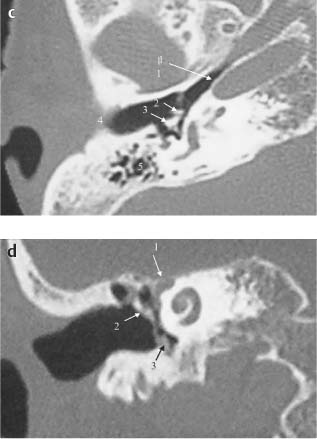
Aeration of protympanum
 Bone Destruction
Bone Destruction
Diagnosis of cholesteatoma
Indication for open cavity
Myringoplasty
 Pneumatization
Pneumatization
Ossiculoplasty in a closed cavity
Ossiculoplasty in an open cavity
Ossiculoplasty
 Preoperative Scans
Preoperative Scans
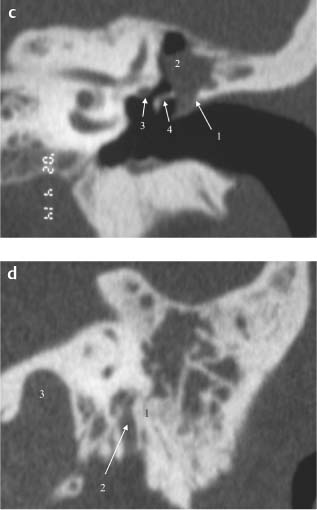
Chronic otitis media with marginal perforation and cholesteatoma
 Postoperative Scans
Postoperative Scans
 Titanium Incus
Titanium Incus
 Incus Interposition
Incus Interposition
Interposition of the TI
Interposition of the TI
 Titanium Total Prosthesis
Titanium Total Prosthesis
 Total Reconstruction of the Ossicular Chain
Total Reconstruction of the Ossicular Chain
 The concepts developed in this book improve the long-term stability of the FTT (foot with spike and cartilage disk; p. 82 and Figs. 158a, b, 159a, b).
The concepts developed in this book improve the long-term stability of the FTT (foot with spike and cartilage disk; p. 82 and Figs. 158a, b, 159a, b).
FTT
FTT
 A thick (1-mm) Silastic sheet effectively protects the inner ear when a FTT is used in an open cavity (see Fig. 160a–c).
A thick (1-mm) Silastic sheet effectively protects the inner ear when a FTT is used in an open cavity (see Fig. 160a–c).
FTT
 The use of a cartilage disk provides adequate stabilization of the shaft of the FTT on the foot-plate, even under difficult conditions (Fig. 161a, b).
The use of a cartilage disk provides adequate stabilization of the shaft of the FTT on the foot-plate, even under difficult conditions (Fig. 161a, b).
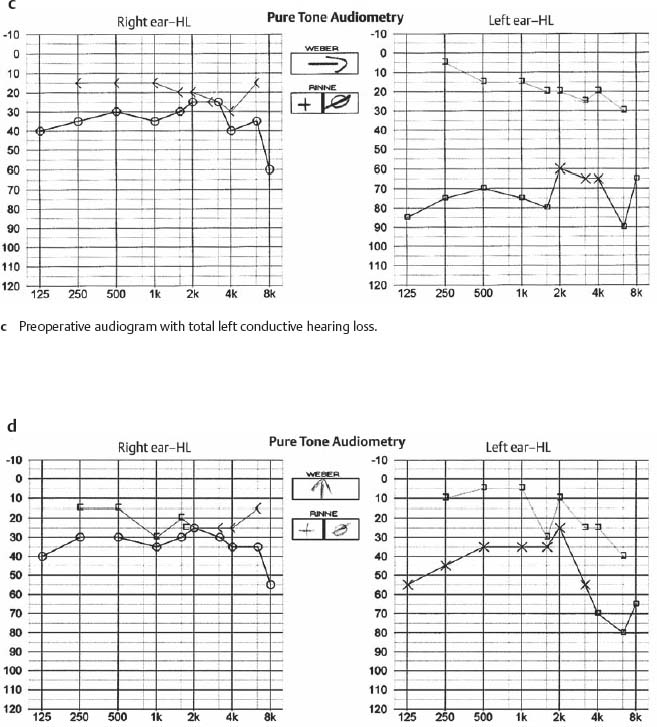
FTT
![]()
Stay updated, free articles. Join our Telegram channel

Full access? Get Clinical Tree



